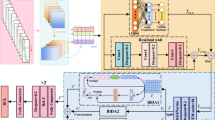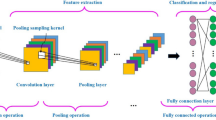Abstract
A single feature cannot show the operational state of a bearing during its entire life cycle. Therefore, a rolling bearing performance deterioration prediction method based on an SAE and the TCN-attention model is proposed. The SAE method is used to fuse the time-domain indicator and the frequency-domain indicator to construct the performance degradation characteristic indicator. The evaluation indices are used to comprehensively evaluate multiple performance degradation indices, and the fused feature indices together, to filter out the features that have a good overall performance. Attention is added to the TCN model, and the output state weight of the TCN model is calculated through a scoring function to increase the important information weight and the prediction accuracy. The appropriate network structure and parameter configuration are determined, and the rolling bearing performance degradation prediction model is established. A validation is performed using publicly available datasets from the University of Cincinnati and XJTU-SY. The results show that the method is more sensitive to the critical information part of the long time series than the other models. At the same time, the average absolute error and the root mean square error are minimized, the accuracy of the rolling bearing performance degradation prediction is high, and the model has a strong robustness and generalization abilities. Additionally, the model has practical engineering value for predicting the health status of equipment.
Similar content being viewed by others
Abbreviations
- W 1 :
-
The weight matrix
- b 1 :
-
The bias matrix
- φ f(•):
-
Activation function of the input layer to the hidden layer
References
X. Wang, H. Gu, L. Xu, C. Hu and H. Guo, A SVR-based remaining life prediction for rolling element bearings, Journal of Failure Analysis and Prevention, 15(4) (2015) 548–554.
C. Yu, Y. Ning, Q. Yong and K. Gao, Prediction of rolling bearing condition degradation trend based on T-SNE sample entropy and TCN, Journal of Instrumentation, 40(8) (2019) 39–46.
P. Wang, L. Deng, B. Tang and Y. Han, Degradation trend prediction of rolling bearing based on auto-encoder and GRU neural network, Vibration and Shock, 39(17) (2020) 106–111+133.
S. Kang, Y. Zhou, Y. J. Wang, J. B. Xie and V. L. Mikulovich, RUL prediction method of a rolling bearing based on improved SAE and Bi-LSTM, Acta Automatica Sinica, 48(9) (2022) 2327–2336.
Y. Zhang, B. Tang, Y. Han and T. Chen, Life prediction for rolling bearings utilizing both failure and truncated samples, Journal of Vibration and Shock, 36(23) (2017) 10–16.
F. Anowar, S. Sadaoui and B. Selim, Conceptual and empirical comparison of dimensionality reduction algorithms (PCA, KPCA, LDA, MDS, SVD, LLE, ISOMAP, LE, ICA, t-SNE), Computer Science Review, 40 (2021) 100378.
Q. Lu, H. Wang and Y. Fu, Application of the fusion of EMD and PCA in fault diagnosis of rolling bearing, Modern Machinery (2017) 8–11.
Y. Yan and W. Jin, Mechanical fault diagnosis method of train bogie based on multi-sensor information fusion, Computer Applications and Software, 37(8) (2020) 48–51.
Z. Huang, L. Tian, D. Xiang and Y. Wei, Wind turbine gearbox oil temperature trend prediction based on PCA and SPC-dynamic neural network, Journal of Tsinghua University (Natural Science Edition), 58(6) (2018) 539–546.
G. Xing and Y. Zhou, Fault diagnosis of rolling bearing based on LMD permutation entropy and LLE, Coal Mining Machinery, 42(3) (2021) 164–166.
S. Du, J. Lv and L. Xi, Degradation process prediction for rotational machinery based on hybrid intelligent model, Robotics and Computer-Integrated Manufacturing, 28(2) (2012) 190–207.
Q. Xu, A. Liu, X. Yuan, Y. Song, C. Zhang and Y. Li, Random mask-based estimation of the distribution algorithm for stacked auto-encoder one-step pre-training, Computers and Industrial Engineering, 158 (2021) 107400.
W. Sun, S. Shao and R. Yan, Induction motor fault diagnosis based on deep neural network of sparse auto-encoder, Journal of Mechanical Engineering, 52(9) (2016) 65–71.
S. Zhao, Y. Zhang, S. Wang, B. Zhou and C. Cheng, A recurrent neural network approach for remaining useful life prediction utilizing a novel trend features construction method, Measurement, 146 (2019) 279–288.
Y. Lei, N. Li, L. Guo, N. Li, T. Yan and J. Lin, Machinery health prognostics: a systematic review from data acquisition to RUL prediction, Mechanical Systems and Signal Processing, 104 (2018) 799–834.
J. Wertz, M. H. H. Shen, O. Scott-Emuakpor, T. George and C. Cross, An energy-based torsional-shear fatigue lifing method, Experimental Mechanics, 52(7) (2012) 705–715.
Y. Wang, C. Yang, D. Xu, J. Ge, W. Cui and Y. Zhang, Evaluation and prediction method of rolling bearing performance degradation based on attention-LSTM, Shock and Vibration, 2021 (2021) 1–15.
Y. Lei, N. Li and J. Lin, A new method based on stochastic process models for machine remaining useful life prediction, IEEE Transactions on Instrumentation and Measurement, 65(12) (2016) 2671–2684.
A. Cubillo, S. Perinpanayagam and M. Esperon-Miguez, A review of physics-based models in prognostics: application to gears and bearings of rotating machinery, Advances in Mechanical Engineering, 8 (8) (2016) doi: https://doi.org/10.1177/1687814016664660.
D. A. Tobon-Mejia, K. Medjaher, N. Zerhouni and G. Tripot, A data-driven failure prognostics method based on mixture of Gaussians hidden markov models, IEEE Transactions on Reliability, 61(2) (2012) 491–503.
R. Wang, H. Jiang, X. Li and S. Liu, A reinforcement neural architecture search method for rolling bearing fault diagnosis, Measurement, 154(2) (2019) 107417.
Y. Pan, M. J. Er, X. Li and R. Gouriveau, Machine health condition prediction via online dynamic fuzzy neural networks, Engineering Applications of Artificial Intelligence, 35 (2014) 105–113.
L. Xiao, X. Chen, X. Zhang and M. Liu, A novel approach for bearing remaining useful life estimation under neither failure nor suspension histories condition, Journal of Intelligent Manufacturing, 28(8) (2015) 1893–1914.
R. Zemouri and R. Gouriveau, Towards accurate and reproducible predictions for prognostic: an approach combining a RRBF network and an autoregressive model, IFAC Proceedings Volumes, 43(3) (2010) 140–145.
M. He, Y. Zhou, Y. Li, G. Wu and G. Tang, Long short-term memory network with multi-resolution singular value decomposition for prediction of bearing performance degradation, Measurement, 156 (2020) 107582.
N. Ding, H. Li, Z. Yin, N. Zhong and L. Zhang, Journal bearing seizure degradation assessment and remaining useful life prediction based on long short-term memory neural network, Measurement, 166 (2020) 108215.
B. Zhang, S. Zhang and W. Li, Bearing performance degradation assessment using long short-term memory recurrent network, Computers in Industry, 106 (2019) 14–29.
Y. Wang, Y. Zhang and H. Li, Adapted receptive field temporal convolutional networks with bar-shaped structures tailored to industrial process operation models, Industrial and Engineering Chemistry Research, 59(13) (2020) 5482–5490.
R. Huang, W. Du and H. Wang, Short-term prediction of wind power considering turbulence intensity, Power System Technology, 43(6) (2019) 1907–1914.
C. Kong, X. Li and J. Du, Prediction of aeroengine exhaust gas temperature based on autoencoder-TCN model, Journal of Air Force Engineering University (Natural Science Edition), 21(5) (2020) 55–61.
Y. Fan, C. Li, Q. Yi and B. Li, Classification of moving targets in fields based on improved TCN model, Computer Engineering, 47(9) (2021) 106–112.
H. Qiu, J. Lee and J. Lin, Wavelet filter-based weak signature detection method and its application on roller bearing prognostics, Journal of Sound and Vibration, 289 (2006) 1066–1090.
I. El-Thalji and E. Jantunen, Dynamic modelling of wear evolution in rolling bearings, Tribology International, 84 (2015) 90–99.
Y. Yang, B. Yu and W. Wang, Research on equipment health prediction technology based on edge computing and VAE-TCN, Procedia Computer Science, 183 (2021) 100–106.
B. Wang, Y. Lei, N. Li and N. Li, A hybrid prognostics approach for estimating remaining useful life of rolling element bearings, IEEE Transactions on Reliability, 69(1) (2020) 401–412.
Acknowledgments
The authors would like to thank Key Laboratory of Advanced Manufacturing Intelligent Technology of Ministry of Education for helpful discussions on topics related to this work. The authors are grateful to Dekang Hou for his help with the preparation of figure in this paper.
Author information
Authors and Affiliations
Corresponding author
Additional information
Yaping Wang was born in Liaoning province, China, in 1972. She received her M.S. degree in Mechanical and Electronic Engineering and Ph.D. degree in Mechanical Manufacturing and Automation from Harbin University of Science and Technology in 2006 and 2010, respectively. She has been a Professor and an M.S. Supervisor with Harbin University of Science and Technology. Her current research interests include signal processing, intelligent fault diagnosis and remaining useful life prediction.
Dekang Hou was born in Zhejiang province, China, in 1999. He received his B.S. degree in Automotive Service Engineering from Zhejiang University City College in 2021. He is currently pursuing the M.S. degree in Mechanical Design and Theory from Harbin University of Science and Technology. His current research interests include rolling bearing fault diagnosis and life prediction.
Di Xu was born in Heilongjiang province, China, in 1991. She received her B.S. degree in Mechanical Engineering and Automation from Harbin Far East Institute of Technology in 2014 and received her M.S. degrees in Mechanical Design and Theory from Harbin University of Science and Technology in 2017. She is currently pursuing the Ph.D. degree in Mechanical and Electronic Engineering from Harbin University of Science and Technology. Her current research interests include rotating machinery fault diagnosis and equipment health management.
Sheng Zhang was born in Jiangsu province, China, in 1997. He received his B.S. degree in Mechanical and Electronic Engineering from Jiangsu University in 2020. He is currently pursuing the M.S. degree in Mechanical Design and Theory from Harbin University of Science and Technology. His current research interests include rolling bearing fault diagnosis and life prediction.
Chaonan Yang was born in Henan province, China, in 1994. He received a Bachelor’s degree in Vehicle Engineering from the International Education College of Henan University of Science and Technology in 2019. He is currently pursuing the M.S. degree in Mechanical Design and Theory from Harbin University of Science and Technology. His current research interests include rolling bearing fault diagnosis and life prediction.
Rights and permissions
About this article
Cite this article
Wang, Y., Hou, D., Xu, D. et al. Prediction of rolling bearing performance degradation based on sae and TCN-attention models. J Mech Sci Technol 37, 1567–1583 (2023). https://doi.org/10.1007/s12206-023-0301-4
Received:
Revised:
Accepted:
Published:
Issue Date:
DOI: https://doi.org/10.1007/s12206-023-0301-4




